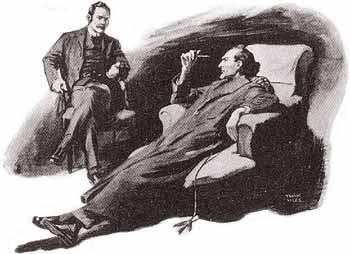A Scion Society of The Baker Street Irregulars

The 17 Steps: The Retired Colourman
Seventeen thoughts for further ponderance of the case at hand – The Retired Colourman (RETI)

AND NOW, THE END IS NEAR . . .
Sherlock Holmes begins this last tale with a sad soliloquy: “But is not all life pathetic and futile? Is not his story a microcosm of the whole? We reach. We grasp. And what is left in our hands at the end? A shadow. Or worse than a shadow — misery.”
Why is Holmes so down? Isn’t this the same guy who said his career would be complete if he just freed London of Moriarty’s influence? Was it Amberley’s story that depressed Holmes so? If so, why?
THE CARD HAD SEEN A LOT OF CALLING
We are told Amberley left Sherlock Holmes “a rather soiled card.” Which was worse etiquette in Victorian London: arriving with no calling card or presenting someone with an old, dirty card? Would a calling card see that much reuse? What amounts did Victorians get them printed in? We are told Amberley is a “pathetic, futile, broken creature,” but how pathetic was handing out dirty calling cards?
THAT MYSTERIOUS AMBERLY CHARM
“Early in 1897 he married a woman twenty years younger than himself–a good-looking woman, too, if the photograph does not flatter.”
Josiah Amberly is a nasty-looking old miser with a shabby home and a bad temper. So how did he ensnare a young and attractive wife? Certainly the future Mrs. Amberly would have had other prospects, wouldn’t she? (It’s interesting to note that Holmes himself is calling her good-looking — quite a change from his early days.)
HE’S A POET AND HE SURE KNOWS IT …
Watson, who seems almost to be wearing a puffy shirt and wielding an ostrich feather quill pen, says: “You know that particular quarter, the monotonous brick streets, the weary suburban highways. Right in the middle of them, a little island of ancient culture and comfort, lies this old home, surrounded by a high sun-baked wall mottled with lichens and topped with moss, the sort of wall– –”
While we’ve seen Watson write like this before, in this case he’s actually speaking this way, which is an entirely different thing. (Just try speaking those lines aloud, as if you were telling Holmes about it.) Does this seem in character for the old army doctor? Might he have been reading from a write-up he did on the way back? Or was it within his character to wax airily aloud about the scenery like that?
THE AMBERLY BODYBUILDING PLAN
“Yet he was not the weakling that I had at first imagined, for his shoulders and chest have the framework of a giant, though his figure tapers away into a pair of spindled legs.”
How did Amberly get such a body? Something in the work of a colourman? Disease? Something that connected with his lost leg?
THE WATSON/ERNEST TRANSITION
“What of Dr. Ernest?” Holmes asks the good doctor. “Was he the gay Lothario one would expect? With your natural advantages, Watson, every lady is your helper and accomplice. What about the girl at the post-office, or the wife of the greengrocer? I can picture you whispering soft nothings with the young lady at the Blue Anchor, and receiving hard somethings in exchange.”
The switch from Dr. Ernest’s womanizing to Dr. Watson’s way with the ladies seems a little too natural. Did Watson become more of a womanizer in the 1890’s? What were his “natural advantages”?
THE CONSULTING DETECTIVE COMES FULL CIRCLE
“Thanks to the telephone and the help of the Yard, I can usually get my essentials without leaving this room.”
Early in his career, Holmes saw his profession with a somewhat Mycroftian view. Clients would bring him their problems, and using his great knowledge of crime, Holmes hoped to advise them without ever leaving his consulting room. As technology advanced, his original thought of simply consulting seems to become more real. Could Holmes have worked in the modern day without ever leaving his sitting room? Might his retirement to Sussex been simply a ruse to cover long-distance work by telephone?
THE MADONNA OF THE VICTORIAN WORLD
“Carina sings to-night at the Albert Hall, and we still have time to dress, dine, and enjoy.”
What do we know about this single-named “Carina”? What sort of thing would she have sung at Albert Hall? Any chance she was not a person, but the 1888 comic opera “Carina” written by one Julia Woolf?
THE SOURCE OF THE TELEGRAM
“Dispatched at 2:10 from Little Purlington,” Holmes says of the telegram we later find to be bogus. Did Sherlock have to go all the way to Little Purlington to send his phony telegram? Or could he have arranged the matter locally?
AMBERLY’S ATTACK OF THE AIR
At the case’s climax, Holmes confronts Amberly with the question, “What did you do with the bodies?”
Amberley then acts most peculiarly: “The man sprang to his feet with a hoarse scream. He clawed into the air with his bony hands.”
Why that reaction? Was he outraged by the accusation and clawing at Holmes? Was he having a sitcom-style, Fred Sanford, over-dramatized fake heart attack?
THE OMINOUS WHITE PELLET
When confronted with his crime, Josiah Amberly also pops a white pill, which Holmes immediately jostles lose by twisting Amberly’s head to face the ground (by placing his hands on Amberly’s throat, no less). Was that anything close to a real method for getting a pill out of someone? Could the pill have been something other than poison, like some stress remedy? And if it was poison, what would Amberly have been most likely to be using to escape justice?
AND WHY DO WE HAVE THESE LAWS . . . ?
Holmes tells the Scotland Yard inspector, “You, for example, with your compulsory warning about whatever he said being used against him, could never have bluffed this rascal into what is virtually a confession.”
If the police couldn’t bluff Amberly into a confession, what validity would Holmes’s use of that tactic have in a court of law? And what was Holmes’s “virtual confession”? Amberly taking a pill?
And if that wasn’t enough, next Holmes himself confesses to burglary in front of Inspector MacKinnon — and a full, true confession at that. This case surely wouldn’t have stood up in court today. Would it have worked at the turn of that earlier century?
THE IRREGULARITIES OF MR. BARKER
“He has several good cases to his credit, has he not, Inspector?” Holmes says of Barker.
“He has certainly interfered several times,” the inspector replies..
“His methods are irregular, no doubt, like my own,” Holmes suggests, seeming not to be too sure of what Barker’s methods are. What might Barker’s irregular methods have been, and how might he have been interfering with police investigations? All we see of him in this tale is that he watches Amberly’s house until he sees someone sneaking out of it, which doesn’t seem much of a method at all. Why did he suspect Amberly to begin with, instead of trying to track the runaway couple?
COVERING THE SMELL OF GAS
Okay, for starters, natural gas has no smell except for the scent added to alert people to its presence in the air, correct? Was the same scent added in Victorian Lewisham as today? How hard was it to get out of a small room that took only two minutes to asphyxiate someone in? Was Amberly’s supposed painting ruse even necessary, especially as he didn’t paint over the one place he might have wanted to — the “We we –” in indelible pencil?
THE CLUE NOBODY SEEMS TO HAVE NOTICED
The paper says, “the subsequent inquiry which led to the discovery of the bodies in a disused well, cleverly concealed by a dog-kennel.”
If merely painting a room was suspicious, why was it that no one fussed over the new dog kennel? Did Amberly, a miser who didn’t even care for his yard, have a dog? Or was the kennel there from previous owners, in which case one must wonder how Amberly even knew of the well.
THE QUESTION OF MOTIVE
While the motive for Amberly’s supposed crime seems obvious enough, what I have to wonder is what Holmes and Barker’s motives might have been for a possible framing of the retired colourman. Given all the questionable tactics, railroading, and general tomfoolery involved in this case, can one not help but wonder if Amberly had been set up. Is there any scenario wherein the former colourman might have been innocent? Could this have been what made the case “the debate of all England” a week later?
THE KEEPER OF THE ARCHIVES
“You can file it in our archives, Watson,” Holmes tells the doctor. “Some day the true story may be told.”
Is Watson acting more like Holmes’s secretary in the later tales than he did early on? Have the individual records and mementos of the two men merged by this time?
The Seventeen Steps originally appeared on the Hounds of the Internet e-list from September 2000 to October 2001 and later on the Sherlock Peoria blog.
 Brad Keefauver, the 41st Garrideb, is the author of The Elementary Methods of Sherlock Holmes, Sherlock and the Ladies, and The Armchair Baskerville Tour. Former publisher of The Holmes & Watson Report, The Dangling Prussian, and a whole lot of obscure, collectable little things on our boy Sherlock. Keefauver is a member of the Baker Street Irregulars and the Adventuresses of Sherlock Holmes.
Brad Keefauver, the 41st Garrideb, is the author of The Elementary Methods of Sherlock Holmes, Sherlock and the Ladies, and The Armchair Baskerville Tour. Former publisher of The Holmes & Watson Report, The Dangling Prussian, and a whole lot of obscure, collectable little things on our boy Sherlock. Keefauver is a member of the Baker Street Irregulars and the Adventuresses of Sherlock Holmes.

Sorry, comments are closed for this post.